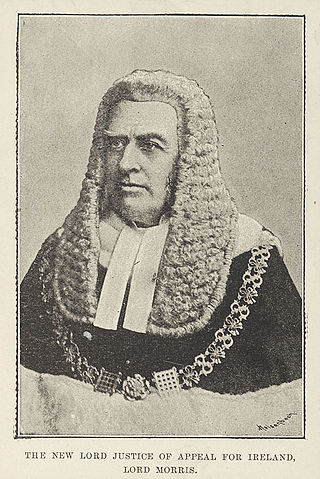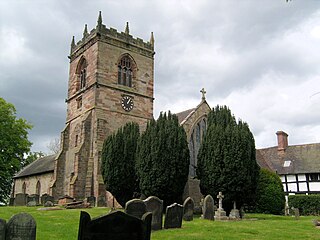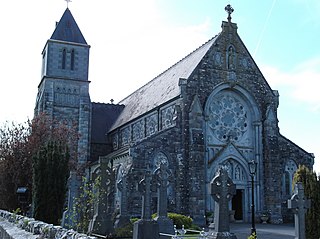Related Research Articles

The Attorney-General for Ireland was an Irish and then United Kingdom government office-holder. He was senior in rank to the Solicitor-General for Ireland: both advised the Crown on Irish legal matters. With the establishment of the Irish Free State in 1922, the duties of the Attorney-General and Solicitor-General for Ireland were taken over by the Attorney General of Ireland. The office of Solicitor-General for Ireland was abolished at the same time for reasons of economy. This led to repeated complaints from the first Attorney General of Ireland, Hugh Kennedy, about the "immense volume of work" which he was now forced to deal with single-handedly.

Lapley Priory was a priory in Staffordshire, England. Founded at the very end of the Anglo-Saxon period, it was an alien priory, a satellite house of the Benedictine Abbey of Saint-Remi or Saint-Rémy at Reims in Northern France. After great fluctuations in fortune, resulting from changing relations between the rulers of England and France, it was finally dissolved in 1415 and its assets transferred to the collegiate church at Tong, Shropshire.

Thomas Cantock, Quantock or Cantok was an English-born cleric and judge in medieval Ireland, who held the offices of Bishop of Emly and Lord Chancellor of Ireland.
Walter de Thornbury was an English-born statesman and cleric in 14th century Ireland who held the office of Lord Chancellor of Ireland. His efforts to secure confirmation of his election as Archbishop of Dublin were cut short by his death in a shipwreck.
John Frowyk was an English-born cleric and judge in fourteenth-century Ireland.
John de St Paul, also known as John de St. Pol, John de Owston and John de Ouston, was an English-born cleric and judge of the fourteenth century. He was Archbishop of Dublin 1349–62 and Lord Chancellor of Ireland 1350–56. He had previously been Master of the Rolls in England 1337–40. Apart from a brief period of disgrace in 1340, he enjoyed the confidence of King Edward III. He was described as a zealous supporter of English rule in Ireland, but also as a pragmatic statesman who was willing to conciliate the Anglo-Irish ruling class. He did much to enlarge and beautify Christ Church, Dublin, although virtually no trace of his improvements survive, as they were destroyed by the Victorian rebuilding of the cathedral.
Nicholas de Balscote was an English-born official and judge in fourteenth-century Ireland. He attained high judicial office, but his career was damaged by a quarrel with King Edward II.
Thomas Minot, also spelt Mynot or Mynyot was an English-born judge and cleric in fourteenth-century Ireland. He was Archbishop of Dublin from 1363 to 1375. He is chiefly remembered for his extensive restoration works to St Patrick's Cathedral, Dublin, and in particular for rebuilding the Cathedral's tower, which is still called Minot's Tower.

Thomas de Cottingham was an English-born cleric and judge who held the office of Master of the Rolls in Ireland.
John Keppock was an Irish judge of the late fourteenth century, who held the offices of Lord Chief Justice of Ireland, Chief Baron of the Irish Exchequer and Deputy Lord Chancellor of Ireland. He became a politician of some importance.
Thomas de Burley was an English-born monk who served as a Crown official and judge in fourteenth-century Ireland. He held office twice as Lord Chancellor of Ireland. He was the Irish Prior of the Order of St. John of Jerusalem, whose Dublin house was at Kilmainham, from 1356 till his death. He had a reputation for corruption, and for vindictiveness towards his opponents, but he could also show courage and determination, especially in combat.

Henry de Motlowe was an English-born judge who briefly held office as Lord Chief Justice of Ireland.

John de Rednesse was an English-born judge who served four times as Lord Chief Justice of Ireland.
John Hunt, le Hunt, Hunter or Hunter del Nash was an English-born judge who served briefly as Lord Chief Justice of Ireland. He was the ancestor of the prominent Longueville family of Wolverton.

Sir William de Notton, or Norton was an English landowner and judge, who had a highly successful career in both England and Ireland, culminating in his appointment as Lord Chief Justice of Ireland in 1361.
William le Petit, Petyt, or Lepetit was an Irish judge who was very briefly Lord Chief Justice of Ireland. He is chiefly notable for having been pardoned for homicide.
Nicholas Lumbard or Lombard was an Irish barrister and judge of the fourteenth century.
Sir Walter Devereux of Bodenham was a prominent knight in Herefordshire during the reign of Edward III. He was a member of Parliament, sheriff, and Justice of the Peace for Hereford.

The recorded abbots of Shrewsbury run from c 1087, four years after Shrewsbury Abbey's foundation, to 1540, its dissolution under Thomas Cromwell. The abbey was large and well-endowed and the abbots were often important political figures as well as ecclesiastical leaders. They varied greatly over the centuries in ethnic and social origins, intellectual attainments and holiness of life. The first two, Fulchred and Godfred, were imported from Normandy. The remainder seem to have been born in Britain and most, but not all, were elected, or at least selected, from the chapter of the abbey. As important territorial magnates, the abbots were always called to take part in the sessions of Parliament from its very beginnings as an institution in 1265. As important figures in the Western Catholic Church, abbots were permitted by the Pope to wear the pontifical ring from 1251 and the mitre from 1397.

Robert de Shardlow, or de Shardelaw (1200-c.1260) was a senior Crown official, diplomat and judge who had a distinguished career in both England and Ireland in the reign of King Henry III of England. He also became a substantial landowner in both countries.